Advertisements
Advertisements
Question
When a 12 V battery is connected across an unknown resistor, there is a current of 2.5 mA in the circuit. Find the value of the resistance of the resistor.
Solution
Voltage V = 12 V
current flowing in the circuit I = 2.5 mA = 2.5 × 10−3 A
∴ Resistance (R) = `"V"/"I"`
= `12/(2.5 xx 10^-3)`
R = `(12 xx 10^3)/25`
R = 4800 Ω
R = `4800/1000` KΩ
R = 4.8 KΩ
APPEARS IN
RELATED QUESTIONS
Will current flow more easily through a thick wire or a thin wire of the same material, when connected to the same source? Why?
A low voltage supply from which one needs high currents must have very low internal resistance. Why?
A resistance of 40 ohms and one of 60 ohms are arranged in series across 220 volt supply. Find the heat in joules produced by this combination of resistances in half a minute.
What is the necessary condition for a conductor to obey Ohm’s law?
In a conductor 6.25 × `10^16` electrons flow from its end A to B in 2 s. Find the current flowing through the conductor (e = 1.6 × `10^-19` C)
- Name and state the law which relates the potential difference and current in a conductor.
- What is the necessary condition for a conductor to obey the law named above in part (a) ?
What is non-ohmic resistor?
The ratio of the potential difference to the current is known as ________.
State Ohm’s law.
A wire connected to a power supply of 230 V has power dissipation P1. Suppose the wire is cut into two equal pieces and connected parallel to the same power supply. In this case, power dissipation is P2. The ratio of `"P"_2/"P"_1` is
Define Current density.
Write a short note on superconductors?
Which of the following I-V graph represents ohmic conductors?
The unit of specific resistance is ____________.
Two cells of same emf E but internal resistance r1 and r2 are connected in series to an external resistor R (Figure). What should be the value of R so that the potential difference across the terminals of the first cell becomes zero.
Suppose there is a circuit consisting of only resistances and batteries and we have to double (or increase it to n-times) all voltages and all resistances. Show that currents are unaltered. Do this for circuit of Example 3.7 in the NCERT Text Book for Class XII.
Why should an ammeter have low resistance?
A current of 3.2 mA flows through a conductor. If charge on an electron is - 1.6 × 10-19 coulomb, find the number of electrons that will pass each second through the cross section of that conductor.
